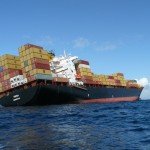Maritime experts battling the toxic tide that has been labelled as the nation’s worst oil spill are expecting easterly winds spreading clots of oil along the Bay of Plenty coast to switch on Thursday, to blow offshore.
 Environment Minister Nick Smith described the grounding of the container ship MV Rena as a significant maritime disaster when hundreds of tonnes of oil escaped as the hull was pounded by high waves and strong winds on Astrolabe Reef. The hull sustained more damage to its bow and additional flooding, and the remaining ship’s crew members were evacuated.
Environment Minister Nick Smith described the grounding of the container ship MV Rena as a significant maritime disaster when hundreds of tonnes of oil escaped as the hull was pounded by high waves and strong winds on Astrolabe Reef. The hull sustained more damage to its bow and additional flooding, and the remaining ship’s crew members were evacuated.
Maritime New Zealand said the weather in the area was poor — with 3m to 4m swells and winds of 37 to 46 kmh — and NIWA forecasters predicted that those winds pushing oil onto the Bay of Plenty coast would peak with gusts of up to 50kmh from the north-north-east during the early hours of Wednesday morning — one week after the grounding. But on Thursday and Friday, the winds are expected to blow offshore, from the westerly quarter – with gusts of up to 30kmh. Some of the oil still floating free could then move offshore, but experts have said that a key issue will be what happens to the oil that is not physically recovered from the sea or shorelines.
Forest and Bird central North Island field officer Al Fleming — based at the Oiled Wildlife Response Unit in Mount Maunganui — said there were an estimated to be 10,000 grey-faced petrels, thousands of diving petrels, white-faced storm petrels and fluttering shearwaters breeding on nearby islands, including colonies on islands off the Coromandel Peninsula and feeding in the Bay of Plenty.
The latest Maritime New Zealand update is available here. The authority said this morning that “130-350 tonnes” was estimated to have leaked from the ship on Monday night.
The SMC gathered the following comments from international experts with experience of oil spills.
National Institute of Water and Atmospheric Research (NIWA) marine ecologist Dr Drew Lohrer comments:
“There are naturally occurring micro-organisms that break down hydrocarbons. However, oil will arrive at the coast much more quickly than the bacteria can breakit down. In areas where the oil arrives in thick slicks or clumps, it may take years or decades for it to disappear naturally. This is why it is imperative to clean up as much of the spill as possible”.
“I don’t have any information on how rates of degradation will differ in different types of habitats. However, rates of breakdown were expected to be much faster in the Gulf of Mexico (Deepwater Horizon spill) than in the Gulf of Alaska (Exxon Valdez spill) due to the much warmer water and air temperatures. The Gulf of Mexico may have higher populations of hydrocarbon consuming bacteria due to numerous natural hot and cold hydrocarbon “seeps” present on the seafloor”.
“A significant slick of black oil has the potential to damage wildlife and the functioning of the ecological systems in coastal systems including sandy and muddy intertidal flats. It can smother the small creatures living on and in the sediments, and the oil’s toxicity can cause longer term problems for the animals that do not immediately succumb. Estuarine tidal flats and wetlands are ecologically important areas that contain an interconnected web of invertebrate, fish and birdlife”.
“(Spraying of) dispersants may help the birds and larger fauna by breaking up the larger thicker slicks and globules. However, the effects of more diffuse and widespread toxicity are unknown. There could be negative effects on organisms including the invertebrates and plants that live in coastal and estuarine areas”.